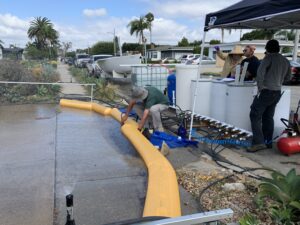Turf replacement study quantifying water-quality benefits of drip-irrigated landscapes

SCCWRP and the County of San Diego have begun working to measure how much irrigation water and rainfall soaks into the ground vs. becomes runoff in residential areas – a foundational study that could transform Southern California’s understanding of the runoff water quality benefits associated with replacing traditional spray-irrigated turf with drip-irrigated, drought-tolerant landscaping.
The two-year study, which moved into the field data collection phase in September following pilot testing, will quantify the ratio of water that soaks into the ground vs. runs off the land – known as the runoff coefficient – across the three main types of land covers commonly found in residential areas: turf lawns, drip-irrigated landscapes, and impermeable surfaces (e.g., concrete driveways). Turf replacement projects are considered a type of non-structural stormwater BMP (best management practice) because they can reduce the volumes of irrigation and wet-weather runoff entering storm drains by making changes to the landscape without an engineered, constructed system.
Although Southern California has historically focused on improving runoff water quality during wet weather, dry-weather flows generated by turf irrigation are the dominant source of residential runoff flows for the vast majority of the year across semi-arid Southern California.
Stormwater managers, however, lack foundational data sets to accurately and comprehensively model how much runoff is generated in these areas during either wet or dry weather, as well as how these runoff volumes change depending on the type of land cover.
Historically, managers have relied on decades-old runoff coefficients published in reference textbooks and practitioner manuals to estimate runoff volumes from turf lawns and impermeable surfaces. Meanwhile, there are no published values at all for drip-irrigated landscaping, which is a relatively new type of land cover.
The SCCWRP-led study will generate a comprehensive set of runoff coefficients for both wet and dry weather across all three main residential land covers; the work will be conducted in three privately managed, inland San Diego County residential communities.
The goal is to build a scientific foundation for stormwater managers across Southern California to robustly quantify the water quality benefits of replacing turf lawns with drip-irrigated landscapes. Quantifying this benefit will enable managers to make informed decisions about how much to invest in this type of non-structural BMP going forward – including in local rebate programs that financially compensate homeowners and business owners who voluntarily replace their turf lawns with drip-irrigated, drought-tolerant landscaping.
The study is motivated by a previous SCCWRP-led study that found that turf replacement projects can successfully eliminate all irrigation runoff during dry weather, as well as all rainfall runoff during 85% of all storms.
Turf lawns can generate high irrigation runoff volumes that, in turn, can transport contaminants into storm drains and downstream aquatic ecosystems. Stormwater discharge permits commonly require stormwater managers to eliminate dry-weather runoff from these areas. Additionally, California will stop allowing homeowners associations and commercial properties to irrigate “non-functional” turf grass with potable water beginning in 2029.
Already, the original study’s findings have helped convince the County of San Diego to expand its turf-replacement rebate program to encompass 13 residential and commercial properties and counting. Meanwhile, the County of Orange has begun laying the groundwork to replicate the study in southern Orange County.
Enabling this study will be a rainfall generator custom-built by SCCWRP that simulates relevant, controlled rainfall patterns, while eliminating much of the variability that surrounds real-world rainfall and runoff events.
For more information, contact Dr. Elizabeth Fassman-Beck.
More news related to: Runoff Water Quality, Stormwater BMPs, Top News